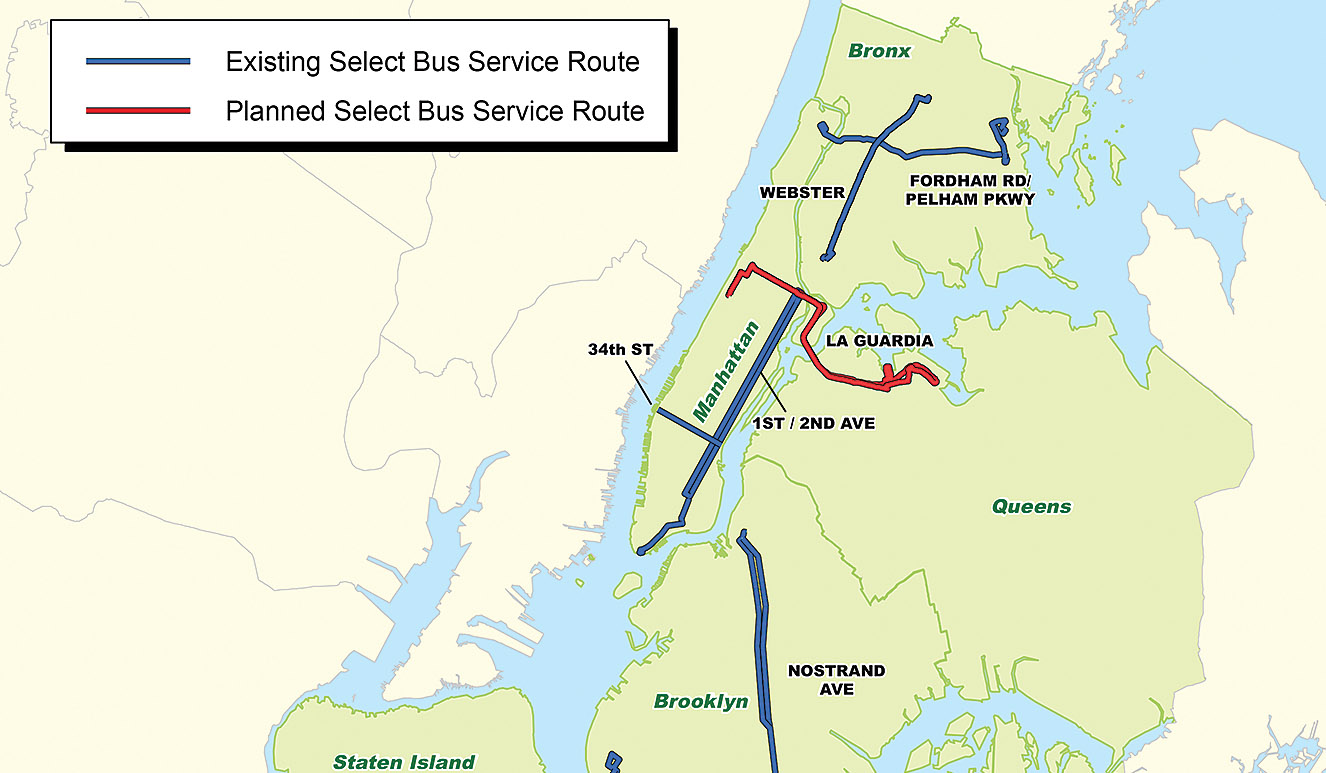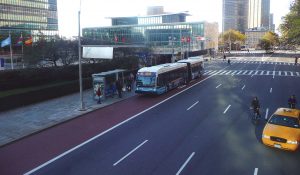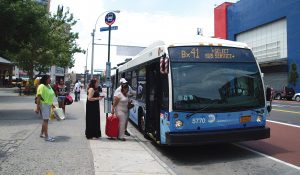
By Theodore Orosz and Eric Beaton
Ten years ago, our transit buses began traveling slower through the streets of New York City. Increasing congestion, double-parking on bus corridors and flagrant parking in bus stops were contributing factors. Although the introduction of low-floor buses improved boarding times, with less interior circulation space, dwell time increased.
Bus ridership had grown rapidly during the 1990s after the introduction of the MetroCard fare collection system, but by 2004 bus ridership had leveled off and was beginning to decline, while subway ridership continued to grow.
The New York Metropolitan Transportation Authority (MTA) operates all rail transit in the New York and Connecticut portion of the New York Region, and all the bus service in New York City. The New York City Department of Transportation (DOT) operates all the streets and traffic signals in New York City. NYC DOT has evolved from a traffic management entity into a robust transportation agency that concentrates not only on commuter vehicles but also pedestrians, cyclists and public transportation. In 2004, MTA and NYC DOT formed a partnership with the goal to implement Bus Rapid Transit (BRT) in New York City. Branded as Select Bus Service (SBS), the recognizable BRT buses are specially painted in a flowing blue pattern.
Through a city-wide screening process involving both a technical analysis and an extensive public engagement process, the agencies were able to identify 15 potential BRT corridors and ultimately select five for implementation.
Today, six BRT corridors are in service, including four routes identified in the initial selection. Early this year, New York City DOT will introduce its seventh corridor.
Select Bus Service Routes
Bx12 Fordham Road SBS launched in June 2008 in the Bronx. This principal crosstown street in the borough connects many rail and subway lines as well as the Bronx Zoo, a teaching hospital and Fordham University. Together SBS and local services carry over 40,000 daily customers on this route.
M15 First/Second Avenues SBS launched in October 2010 to several very dense residential neighborhoods and several colleges and hospitals, and has since become the single busiest bus route in New York City, transporting over 50,000 customers. After its stop at Wall Street, the route ends in an-off-street facility at the Staten Island Ferry Terminal.
M34 SBS began service in November 2011 to provide crosstown circulation on 34th Street, and connecting with Penn Station, numerous subways, the Convention Center and a teaching hospital. The route carries approximately 20,000 weekday customers.
S79 Hylan Boulevard SBS launched in September 2012 is a 15-mile long route that crosses the Verrazano-Narrows Bridge connecting a regional mall on Staten Island with a subway terminal in Brooklyn. This route carries approximately 9,000 weekday customers and does not have Off-Board Fare Collection.
Bx41 Webster Avenue SBS began running in the Bronx in June 2013. Upon completion this route will feature a new transit center at each terminal, as well as a new transit center where it intersects Bx12 SBS. Some distance from subway lines, the Bx41 carries 20,000 weekday customers on SBS and local services. This corridor is roughly parallel to the former 3rd Avenue El, torn down in the 1970s.
B44 Nostrand/Rogers/Bedford Avenues SBS in Brooklyn began service in November 2013, carrying approximately 40,000 daily customers riding SBS and local services. This route provides both line-haul and subway feeder service and serves two busy commuter colleges.
SBS funding sources
Funding for the SBS corridors has come through a mix of MTA and New York City local capital money, as well as FTA and FHWA grants to New York City to pay for more extensive street work such as bus bulbs. MTA purchases buses and fare equipment with local funds. Generally, the cost of BRT implementation in New York City is approximately $1 million per mile — excluding the federally funded bus bulbs and the cost of the buses.
A FTA New Start with New York City as the grant recipient funded the B44 SBS corridor. These federal funds allowed MTA and DOT to implement a new route with much more robust BRT service that began immediately when it launched in November. This is in contrast to the other SBS corridors where the agency added bus bulbs and other BRT elements only after service began.
BRT criteria met
The Select Bus Service qualified for FTA funding specific to BRT by meeting these specific requirements. In addition to the specially branded SBS buses, the system includes:
• Off-board fare collection (OBFC) at every SBS station.
• Thirty-eight miles of camera-enforced BRT lanes clearly designated in red paint; curbside or in some instances one lane to allow loading, drop-offs, parking and right turns at the curb.
• Forty 40 SBS stations with bus bulbs by the end of 2014 with sidewalks extended out to meet the bus lane.
• SBS stations with 10-inch curbs to allow near level boarding.
• New stainless steel bus shelters. Benches, bike racks, new sidewalks and refuges in the center of busy arterials.
• Coming: New York City Transit Bus Time system with real-time arrival information.
SBS rolling stock
The MTA runs approximately 5,700 buses operated through several affiliates. Standard transit buses comprise the majority of the fleet in a mix of Nova RTS, Orion high-floor, Orion and New Flyer low-floor models, and Prevost coaches. While most standard buses are diesel, the agency runs approximately 700 CNG buses and 1,650 hybrid buses.

In addition to the Nova LF articulated vehicles, New Flyer high-floor and low-floor articulated buses bring the articulated total to approximately 500. The agency also runs approximately 900 MCI coaches for expressway services to the CBD.
Nova 60LF three-door, low-floor diesel articulated buses run on all corridors except one. Although the Nova articulated buses have been deployed on other high-volume routes, MTA and DOT initially purchased this model bus specifically for use on Select Bus Service.

Is SBS really BRT?
While there are those who want to argue about whether New York’s SBS program is bona fide Bus Rapid Transit, MTA and DOT think it is important to measure a program by its results and not
by semantics.
On each SBS route, we have observed approximately a 20 percent improvement in driving speed and a 10 percent growth in ridership that totals approximately 140,000 weekday customers. The increase is extraordinary for a mature transit market; even more so in an environment where citywide bus ridership was on serious decline.
